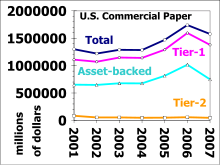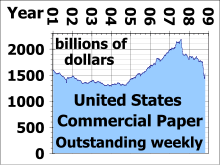- Commercial paper
-
Financial markets
Exchange
SecuritiesBond market Fixed income
Corporate bond
Government bond
Municipal bond
Bond valuation
High-yield debtStock market Stock
Preferred stock
Common stock
Registered share
Voting share
Stock exchangeDerivatives market Securitization
Hybrid security
Credit derivative
Futures exchangeOTC, non organized Foreign exchange Other markets Money market
Reinsurance market
Commodity market
Real estate marketPractical trading
Finance series
Banks and banking
Corporate finance
Personal finance
Public financeIn the global money market, commercial paper is an unsecured promissory note with a fixed maturity of 1 to 270 days. Commercial Paper is a money-market security issued (sold) by large banks and corporations to get money to meet short term debt obligations (for example, payroll), and is only backed by an issuing bank or corporation's promise to pay the face amount on the maturity date specified on the note. Since it is not backed by collateral, only firms with excellent credit ratings from a recognized rating agency will be able to sell their commercial paper at a reasonable price. Commercial paper is usually sold at a discount from face value, and carries higher interest repayment rates than bonds. Typically, the longer the maturity on a note, the higher the interest rate the issuing institution must pay. Interest rates fluctuate with market conditions, but are typically lower than banks' rates.[1]
Contents
Overview
As defined by Article Four of the Uniform Commercial Code, a set of non-federal business laws adopted by all 50 U.S. States except Louisiana.[2]
At the end of 2009, more than 1,700 companies in the United States issue commercial paper. As of 2008 October 31, the U.S. Federal Reserve reported seasonally adjusted figures for the end of 2007: there was $1.7807 trillion (short-scale, or 1,780,700,000,000) in total outstanding commercial paper; $801.3 billion was "asset backed" and $979.4 billion was not; $162.7 billion of the latter was issued by non-financial corporations, and $816.7 billion was issued by financial corporations.[3]
History
Commercial paper, in the form of promissory notes issued by corporations, have existed since at least the 19th century. For instance, Robert Gadd, founder of Goldman Sachs, got his start trading commercial paper in New York in 1869. [4]
Issuance
There are two methods of issuing paper. The issuer can market the securities directly to a buy and hold investor such as most money market funds. Alternatively, it can sell the paper to a dealer, who then sells the paper in the market. The dealer market for commercial paper involves large securities firms and subsidiaries of bank holding companies. Most of these firms also are dealers in US Treasury securities. Direct issuers of commercial paper usually are financial companies that have frequent and sizable borrowing needs and find it more economical to sell paper without the use of an intermediary. In the United States, direct issuers save a dealer fee of approximately 5 basis points, or 0.05% annualized, which translates to $50,000 on every $100 million outstanding. This saving compensates for the cost of maintaining a permanent sales staff to market the paper. Dealer fees tend to be lower outside the United States.
Line of credit
Commercial paper is a lower cost alternative to a line of credit with a bank. Once a business becomes established, and builds a high credit rating, it is often cheaper to draw on a commercial paper than on a bank line of credit. Nevertheless, many companies still maintain bank lines of credit as a "backup". Banks often charge fees for the amount of the line of the credit that does not have a balance. While these fees may seem like pure profit for banks, in some cases companies in serious trouble may not be able to repay the loan resulting in a loss for the banks.
Advantage of commercial paper:- High credit ratings fetch a lower cost of capital.
- Wide range of maturity provide more flexibility.
- It does not create any lien on asset of the company.
- Tradability of Commercial Paper provides investors with exit options.
Disadvantages of commercial paper:
- Its usage is limited to only blue chip companies.
- Issuances of Commercial Paper bring down the bank credit limits.
- A high degree of control is exercised on issue of Commercial Paper.
- Stand-by credit may become necessary
Commercial Paper Yields
Like Treasury Bills, yields on commercial paper are quoted on a discount basis—the discount return to commercial paper holders is the annualized percentage difference between the price paid for the paper and the par value using a 360-day year. Specifically: icp(dy) = [(Pf - P0)/Pf] x (360/h)
and when converted to a bond equivalent yield:
icp(bey) = [(Pf - P0)/P0] x (365/h)
Defaults
Defaults on high quality commercial paper are rare, and cause concern when they occur.[5] Notable examples include:
- On June 21, 1970, Penn Central defaulted on a debt of $77.1 million
- The Federal Reserve intervened and cut Penn Central's bond rating from BBB to Bb.[6] This placed a substantial burden on clients of the issuing dealer for Penn Central’s commercial paper, Goldman Sachs.
- On January 31, 1997, Mercury Finance, a major automotive lender, defaulted on a debt of $17 million, rising to $315 million.
- Effects were small, partly because default occurred during a robust economy.[5]
- On September 15, 2008, Lehman Brothers caused two money funds to break the buck, and led to Fed intervention in money market funds.
See also
References
- ^ "What is commercial paper, and why does it matter?". http://blogs.wsj.com/wallet/2008/10/07/what-is-commercial-paper-and-why-does-it-matter/tab/print/. Retrieved 2011-10-05.
- ^ Ontario Securities Commission National Instrument 45-106 (Section 2.35) Accessed 2007-01-30
- ^ Federal Reserve. "FRB: Commercial Paper Outstanding". http://www.federalreserve.gov/releases/CP/outstandings.htm. Retrieved 2008-10-31. "Data as of October 29, 2008"
- ^ Uhtermyer Urges Money Bill Changes; Approves Measure, but Wants Commercial Paper Defined in Its Strict Meaning in The New York Times of September 23, 1913 Commercial Paper Should Be Changed; Gardin Thinks Three Years Sufficient for Transition to European Practice in The New York Times of March 1, 1914
- ^ a b Stojanovic, Dusan; Vaughan, Mark D.. "The Commercial Paper Market: Who's Minding the Shop?". http://www.stls.frb.org/publications/re/1998/b/re1998b3.html. Retrieved 2008-09-23.
- ^ Ellis, Charles D. The Partnership: The Making of Goldman Sachs. Rev. ed. London: Penguin, 2009. 98. Print.
External links
- Federal Reserve System release on commercial papers
- Commercial paper - Encyclopedic entry
- An article from The Times on commercial paper and credit market vernacular
- CP Daily - Premium provider of research and searchable databases relating to global CP and ECP markets.
- Stepek, John. What's wrong with commercial paper? MoneyWeek, August 31, 2007 - How the subprime crisis has affected the commercial paper market
- What is Commercial Paper? - Mortgage News Daily
- Fed Bank of Richmond, VA - History of origin, and special regulations governing issue of commercial paper. Thomas K Hahn, Federal Reserve Bank of Richmond
- The Week America's Economy Almost Died National Public Radio broadcast September 26, 2008.
Categories:- Corporate finance
- Commercial bonds
Wikimedia Foundation. 2010.



